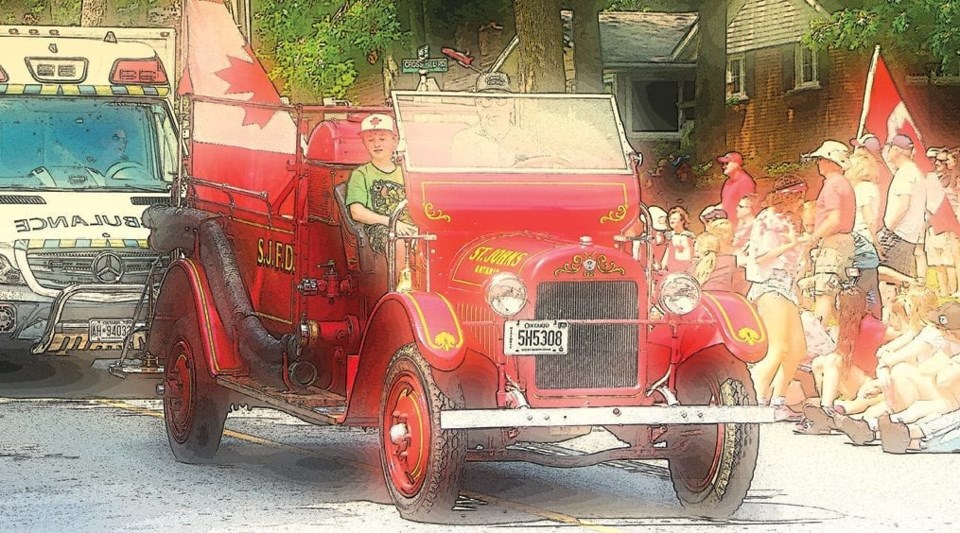BY SAMUEL PICCOLO Special to the VOICE
It’s the first of July and there is something going on in the streets.
There are clumps of people shuffling along the sidewalks all in the same direction, all carrying the same jumble of lawn chair, cooler, and hat.
Others have already given up walking and, judging the present spot good enough, splayed their own seat out on its trembling limbs and begun to recline. Perhaps this is not a bad idea, since where the rest are heading the crowd seems to be denser. Following them, there is no loudening din that one encounters at a concert or similarly large spectacle, but there is a buzz of some perceptible sort. There is enough red to outfit a nation of matadors.
“You only get three whacks, buddy,” a father says to his son, who is
determinedly plonking at a high striker’s pad. “Why don’t you go over and jump around in that castle?” The boy trundles over to where other kids are lining up to climb through the inflated door and bounce about. His father follows him from a few paces back and, seeing that his son is safely––or unsafely––inside, sniffs the air. There are puffs of a fragrant smoke hovering, and he looks to where they are coming from.
In the centre of a patch of grass there are a number of blankets laid down and a group of people standing on them. Several women are moving around the blankets, reading aloud the litany of woes that befell the people living in North America when Europeans began arriving. Those standing on the blankets are asked to step off as another misfortune is announced, representing those First Nations people who died from direct or indirect contact with the arriving peoples. These facts of history are amplified through a low-volume speaker, but there is another one squawking out music not far away, making the recitation decipherable to only those in the immediate vicinity. It is as if the two speakers are competing in some event that neither has the ability to win, like a dunk contest in which none of the participants can get above the rim. Standing between them, I can’t quite make out which Indigenous catastrophe is being recounted, nor can I hear the lyrics of any song well enough to sing along. Most of those moving off the blankets look to be Canadians of European descent, and they are solemn. The face paint on some of the younger ones manages not to detract from this solemnity. They must have navigated their route to this destination in the opposite direction, moving clockwise from food to paint to blanket.
Nearby sits a face painter. There is a little congregation of pale-faced kids who, from afar, seem eager to acquire a little colour. Up close, it isn’t clear that they still feel this way at the front of the line. The artist is bald man with thick, heavily tattooed arms. He is gentle and friendly, though, as he holds a pattern to a kid’s head with one latex-wrapped paw and with the other squeezes the trigger on a pressurized paint gun. Those heading for the chair go silent before they are instructed to keep their mouth shut tight.
There are plenty of mouths open wide further along where the food is sold and no one is going hungry. The fare isn’t especially surprising, though there are deep-fried oreos on offer, and this seems like the closest thing here to a genuine Near-Death Experience, until I catch sight of a sign advertising a poutine-eating contest. A few people around have decided that they can’t wait that long––or perhaps they are just warming up their digestives juices?—and it takes a bit of a walk, past a classic car on raffle, until the air is again clear of boiling oil's fragrance.
That’s enough here. There are still many more people arriving than leaving, but the real buzz is out the gates and up the street, where apparently a parade is about to start. This is what everyone has been bivouacking by the road for, and if they keep their expectations reasonable they will not be disappointed.
There is a terrific mix of floats. The Mayor and the MPP are there, but so too is a trailer with “Names Matter” emblazoned on its side, keeping up the fight against the name of the newly fused Pelham Centre and E.W. Farr school. This group is followed by the predictable dancers and banal business floats, and the overall effect of the barely-stifled pre-parade enthusiasm is pleasant.
The most awe-inspiring participants are the two Clydesdales that have been hired to pull a carriage. Their backs are nearly over my head, and they are knocking their shoed hooves on the asphalt, making sharp, powerful snapping noises, and ruffling the tufts of white hair that mark their ankles. Their heads are immense, long and dark, and when they close their and eyes and mouths and conceal those cream-coloured teeth they appear as great granite tombstones hovering in the air.
Their vision is further restricted by blinders, and good thing too, since the MPP's truck has bright balloons affixed to its roof, weaving and ducking, and eliciting a warning from the carriage-driver that the horses might give a start if they catch sight of them.
"They weigh two thousand pounds each," he says.
The balloons are tied down, and the dancers make formation. It is starting.
As the show moves down the street, the spectators decamp. Some follow the parade's stern. Others collect what's theirs, cut down side streets, unlock cars, head back home. There is still a lot of July 1st left. ♦



